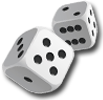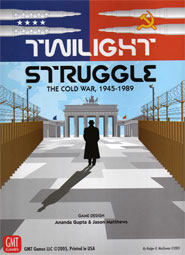



play board games
Board game reviews, strategy tips & session reports
Twilight Struggle Review
 Stats:
Stats:
No. of players: 2
Amount of time to play: 180 min
Age requirements: 12+
Set-up time: 10-15 minutes
Twilight Struggle Rules Description:
Twilight Struggle is a two player war game that simulates the Cold War. You play as either the USA or USSR and spread their in influence the world. All while avoiding World War III.
Twilight Struggle is a card-driven game. The game lasts 10 turns, until one player scores 20 points or you start WWIII (and lose). The 10 turns are segmented into Early War, Mid-war and Late War. The cards correspond to that historical period and come into play based on the turn.
Cards have an Operations value and an Event. Some events are associated with the USA, others with the USSR and some are unassociated.
Each turn you play a card as a Headline. Cards played as a Headline, are only used for their events. Next you and your opponent take turns playing cards. If you play a card associated with your superpower or one not associated with either superpower, you can play it as either an Event or for the Operations Value. If you play a card associated with your opponent’s superpower, they get use the Event and you must use it for its Operations Value.
Operations include placing influence, realignment and coups. The higher the Operations Value of the card you use for Operations the more effective it is. Higher valued cards also have Events that can help you (or your opponent) a lot. You will have to weigh using the card for its Operations Value versus its Event. This is even more important if it is associated with your opponent’s superpower.
The only way to avoid playing a card associated with an opponent’s superpower and not triggering the event is by using it in the Space Race. The Space Race can score you some victory points and give you special abilities.
Scoring cards are unassociated and score regions on the map. You gain points by having more influence in the right places within a region than your opponent.
The DEFCON track shows just how close you are to causing WWIII. It only has five spaces and each coup attempt will drop the DEFCON level by one. As the level drops you will not be allowed to try coups and realignment rolls in certain regions.
You must perform Military Operations that equal the DEFCON level. Failure to do so can lose you victory points.
If you make it through 10 turns, the regions all score one last time. The Scoring Track ranges from 20 points for each player and you move a marker between the two ends. This lends itself to the tug of war nature of the game. Some rounds you’ll pull the VP marker your way and sometimes your opponent will tug it right back.
Quick Twilight Struggle Review:
Twilight Struggle is an intense game that will call for your full attention. It will also take you a game or two to understand and develop some strategies to win. Just like the Cold War it is modeled after, Twilight Struggle has a lot of tension.
One of the biggest things to learn is how to deal with cards that help your opponent and you. High numbered cards can help you realize your goals. But if the event helps your opponent, you may need to make a tough decision.
Twilight Struggle has tons of theme and is even educational. The way real world events have been implemented on the cards is impressive. You’ll play and learn (or remember) things that you learned about the Cold War in highschool.
The components and rules are great for this game. You may forget a couple things your first couple plays, but the rules are well-organized and numbered for easy reference. The basics of Twilight Struggle are easy to teach. The fine nuances that make you a better player require you to play the game more. And you’ll want to. Twilight Struggle lends itself to post-game analysis.
The game is long, especially if you are playing with someone new or who suffers from analysis paralysis. The time does fly by but you may have trouble getting it to the table as often as you’d like. If like lighter games then you might want to steer clear of Twilight Struggle. It is a brain-burner.
The only other negative about Twilight Struggle is that newbies will have a tough time against experienced players. Like I said there is a lot to grasp and work with in Twilight Struggle. That is one of the reasons it is so good. But if you have played a handful of games you’ll have a distinct advantage over someone you are teaching. This won’t bother some new players, but others will be frustrated.
There is a reason Twilight Struggle is rated #1 on BGG. It is an excellent game that is well-balanced. You will play it and want to play again, win or lose. And you should cause playing more will help you become a better player. If you get the chance I highly recommend you try Twilight Struggle out.
Score and synopsis: (Click here for an explanation of these review categories.)
Strategy 6 out of 6
Luck 4 out of 6
Player Interaction 6 of 6
Replay Value 5 out of 6
Complexity 4 out of 6
Fun 6 out of 6
Overall 6 out of 6

Leave a Reply